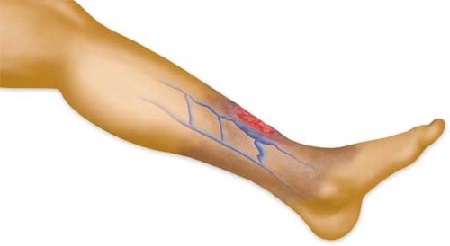Two joint bags (bursa) participate in the normal functioning of the heel joint. They reduce friction and perform a protective function, protecting the structure of the ankle from injury and overload.
One of the synovial bags is located between the Achilles tendon and the calcaneus, the inflammatory process that develops in it is called Achilles bursitis.
The second (superficial) - between the skin and the tendon of the heel (Achilles), its inflammation is called the podpyatochnym or posterior bursitis of the foot.
Content
- 1Causes of bursitis
-
2Clinical manifestations of the disease
- 2.0.1Acute bursitis of the heel
- 2.0.2Chronic heel bursitis
- 2.0.3Purulent heel bursitis
- 2.0.4Traumatic bursitis
- 3Methods of diagnosing the disease
-
4Methods of treatment of calcaneal bursitis
- 4.0.1Immobilization
- 4.0.2Medication Therapy
- 4.0.3Physiotherapeutic methods of treatment
- 5Rehabilitation period
Causes of bursitis
It is possible to distinguish several groups of factors that provoke the development of the inflammatory process in the synovial bags of the ankle joint.
Genetically determined factors:
- congenital defects of the ankle structures;
- weakness of the ligamentous apparatus strengthening the joint;
- a genetically determined tendency to develop an achillobursitis, transmitted from generation to generation.
Mechanical factors of the disease:
- excessive physical workload in connection with professional work, sports, excess weight;
- non-penetrating traumatic injuries of the ankle - bruise or stroke;
- prolonged hypothermia (skating, skiing, walking in an inappropriate for the season shoes);
- wearing a narrow, uncomfortable, not suitable for the size of shoes, especially if it is high-heeled (heel height exceeds 4 cm).
Infectious factors:
- penetrating wounds in the ankle (puncture or cuts);
- specific diseases can cause the development of a specific Achillobursitis (gonococcal infection, tuberculosis);
- nonspecific diseases - metabolic uremia, polyarthritis, angina;
- Bursitis of the foot can develop against the background of endocrine system diseases (diabetes mellitus), metabolic disorders (obesity) or changes in the hormonal background (in women during menopause).
Clinical manifestations of the disease
The main manifestation of the disease is pain syndrome,the severity of which depends on the form of the disease and the duration of its development.
In addition to pain can develop:
- puffiness,
- restriction of motor activity,
- local hyperemia (redness) and hyperthermia (increased skin temperature),
- sometimes there is an increase in body temperature.
Acute bursitis of the heel
With acute bursitis of the heel, the pain arises abruptly, is intolerant and intensifies when you try to touch a sore spot or stand on your foot.Puffiness and restriction of movements make a person almost immobile for several days. Skin over the patient area is sharply hyperemic, their temperature is increased.
Chronic heel bursitis
This form is characterized byprolonged course and the presence of periodic exacerbations.The symptomatology of the disease is not expressed sharply, during the periods of remission it can not be felt at all, in the moments of exacerbations the pain syndrome, insignificant puffiness and hyperemia of the affected area develop.
Purulent heel bursitis
The cause of its development is often streptococcal or staphylococcal infection,which can get into the joint cavity with penetrating wounds of this area. The inflammatory process quickly irradiates through the lymphatic system into the tissues surrounding the ankle.
Traumatic bursitis
After an open ankle injury, acute bursitis develops most often. In the synovial bag, exudate and blood gathers, with time the fibrin fibers begin to form, gluing the vessels and tissues. The walls of the bursa thicken due to the fact that it is covered with a connective tissue.In the absence of treatment, the walls of the synovial bag gradually harden, they penetrate the calcareous deposits, and calcareous bursitis can develop.
Methods of diagnosing the disease
To make a diagnosis, you need:
- Conduct a clinical examination of the affected area with palpation and the determination of functional disorders of the ankle joint.
- To make an x-ray photograph.
- Conduct laboratory studies that include general analyzes (blood and urine) and investigation of synovial fluid obtained when puncturing the joint.
Methods of treatment of calcaneal bursitis
The purpose of complex therapy- eliminate the pain syndrome and inflammatory process, and then restore the normal trophism of the synovial bags and the full functionality of the joint.
Immobilization
The patient's joint needs complete immobilization for the entire time of the acute period of the disease - it is possible to immobilize the ankle with the help of gypsum langas, orthopedic adaptations.
Medication Therapy
The choice of drugs depends on the cause that caused the disease, its clinical picture and the severity of the pain syndrome.
Can be applied:
- non-steroidal anti-inflammatory drugs (movalis, mexylocam, diclofenac, ibuprofen);
- hormonal intraarticular injections (hydrocortisone);
- antibiotics, if necessary, are selected individually (with purulent and specific Achillobursitis).
Physiotherapeutic methods of treatment
Physiotherapy is prescribed only after arresting the acute stage of the disease, eliminating pain and inflammation.
Can be applied:
- ultraphonophoresis with lidase or hormonal preparations;
- magnetotherapy;
- cryotherapy;
- laser treatment;
- massage.
Surgical methods of treatment
Operative methods for treating bursitis of the foot are used in severe calcareous, purulent forms of the diseaseand in those cases when conservative therapy did not bring positive results:
- Puncture is a puncture of the synovial bag with subsequent removal of excess joint fluid and the introduction of corticosteroid drugs.
- Excision of the synovial membrane of the joint bag with its subsequent treatment with special solutions.
- Complete removal of the synovial bag.
Rehabilitation period
In the early days of the field of surgical treatment requires complete immobilization of the ankle,daily change of dressings, use of elastic bandage to prevent the development of thrombosis of the veins of the lower limb.For four weeks, the full load on the ankle is restored.
To prevent the recurrence of the disease, it is necessary to stabilize your weight, wear comfortable wide shoes and avoid excessive load on the ankle.


